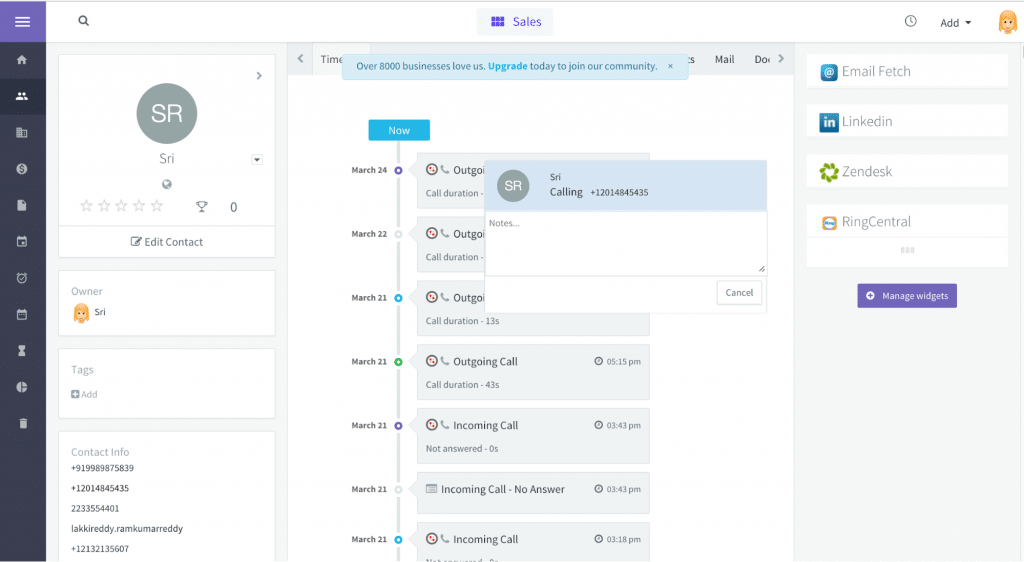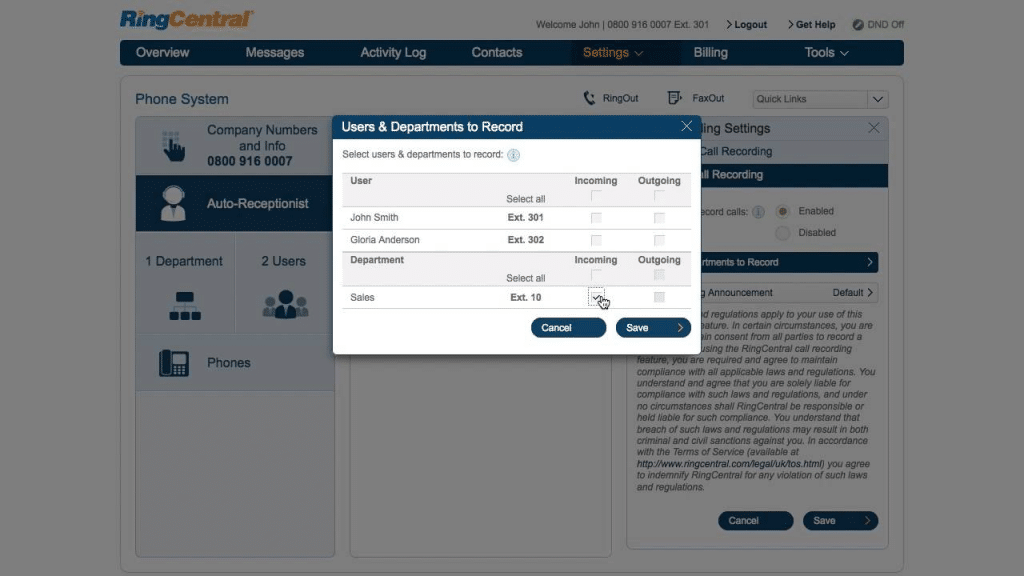Cold calling used to be the go-to prospecting tactic for salespeople.
But today, this old school sales technique seems to be on the downswing.
In this post, we’ll look at why cold calling still deserves a place in your sales workflow, and we’ll break down the do’s and don’ts of building a winning cold calling strategy.
What we’ll cover:
Let’s start by looking at whether cold calling still works in sales.
Up your prospecting game and close more deals with these free cold calling scripts. ☎️
Is cold calling dead?
There’s no doubt that the popularity of cold calling has dwindled in recent years. This comes down to a variety of factors.
The first is that the rise of email, social media, and other digital communication channels means that brands now have many more ways to both reach out to prospects and nurture their relationships with existing customers. (Hello, customer retention.)
At the same time, buyers today are more empowered than ever: the immediate access to reviews and product information, combined with the proliferation of new competitors, makes it harder to sway people even with a well-executed cold call.
Another reason cold calling has declined comes down to taste and trust. Many people have learned from bad experiences to be skeptical of unsolicited calls from salespeople. Even salespeople themselves are often uncomfortable with the idea of calling people out of the blue.
Legal changes over the past twenty years have also put the brakes on cold calling. In 2003, the National Do Not Call registry was created to ban cold calls to anyone who registered themselves on the database (which now exceeds 200 million numbers). And in 2018, the European Union (EU) introduced the General Data Protection Regulation (GDPR), which effectively banned business-to-consumer (B2C) cold calls to EU citizens.
Taken together, these developments have caused many commentators to declare the death of cold calling. But the reality is a little more nuanced…
While it’s true that cold calling has become harder to pull off, it’s still the case that 46% of B2B salespeople list phone calls as one of the main ways they reach out to prospects.1 In fact, almost 70% of buyers have accepted a call from a new salesperson in the past 12 months.2
Why, then, do so people dismiss cold calling as an obsolete sales tactic?
The problem is that many salespeople approach cold calling the wrong way. Instead of viewing it as an opportunity to introduce their services and spark a relationship with a highly-qualified potential customer, they see it as a scattergun method of pitching to as many prospects as possible with the aim of making a quick sale.
As we’ll see, the right approach to cold calling is to provide a positive context tailored specifically to the needs of the prospect you’re contacting. With that in mind, let’s look at what you can do to make your cold calling strategy a success.
9 tips to help you win at cold calling
1. Build a targeted list of prospects
Long before you pick up the phone, your first task is to create a list of highly-qualified prospects who you think would find some real value in the products or services you offer. There’s no use reaching out to prospects who have no need for what you sell.
Start by defining what problems your product solves for your target market and identify job titles held by key decision-makers within that niche.
You can then use a tool like LinkedIn to search for prospects that fit your ideal buyer profile.
2. Use the right tools
The cold calling process is much more efficient when your sales team is equipped with the right toolkit.
Tools like cold calling software, customer relationship management (CRM) systems, and sales software can all make life easier for salespeople and free up their time to focus on pursuing new leads and building new customer relationships.
For example, RingCentral’s phone system can help salespeople boost their pick-up rates by using the local phone numbers feature, which lets you select from more than 200 area codes when placing a call. The prospects you call will see your local number as your outbound caller ID and may be more tempted to answer if they think you’re a local company. Here’s a quick look at some of the outbound features that’ll come in handy when you’re selling:
You can also hook RingCentral up to CRM (customer relationship management) platforms like Salesforce, Zoho CRM, and Agile CRM to dial your cold calls directly from your computer screen:
3. Research each individual prospect
Next, you’ll want to find out as much as you can about your individual prospects and the companies they work for. Doing your homework beforehand will make it far easier to build rapport and establish trust when you eventually call your prospects.
Look out for any interesting details about them and their company. Where did they go to college? Have they recently changed roles? Have they recently published a blog post? Has the business been featured in any industry news lately?
Building this picture before you make a call will equip you with multiple conversational “hooks” straight off the bat.
4. Create a script
Since time is precious when making a cold call, it’s a good idea to prepare what you’re going to say in advance.
The purpose of a cold call script is to keep your call on track and to minimize hesitation and awkward pauses. Of course, once you’ve gotten past your pre-planned sales conversation starter, you should let the conversation evolve naturally and freestyle when necessary, but having a script to hand will help you stay focused on the central goal of your call.
At a minimum, your script should map out your introduction, your positioning statement, and your invitation to schedule a follow-up call or meeting.
5. Add a human touch
Although sales apps and scripts are invaluable tools to have at your disposal, you have to make sure your delivery is on-point too. You don’t want to seem overly-rehearsed or polished. This is business, yes, but you still want doing business with you to be a pleasant experience.
Let your warmth and personality shine through so that you come across as more relatable to your prospects. This will make them less guarded and more willing to engage in a conversation.
You can use your research to ask specific questions about them and their company to get the discussion moving.
For example: “I saw that your team has recently moved into a new office building. It looks really cool! How are you finding it?”
The more you can get them talking about their work, the more you’ll be able to inject your own observations about them and their business needs. Having this kind of engaged dialogue is fertile ground for growing a business relationship.
6. Keep it short
It’s important to be mindful of your prospect’s time and appreciate that you’re essentially intruding on their day.
From the moment a prospect answers your call, you have roughly 10 seconds to pique their interest and prove your value before they hang up. You should, therefore, make sure your introduction succinctly explains who you are, where you’re calling from, and what value you can bring their business.
You can also reassure your prospect that you intend to respect their time by acknowledging the intrusion upfront.
For example: “Hello, [their name], it’s [your name] here from [your company]. I appreciate you weren’t expecting a call from us today, but I really think we can help you [achieve desired result]. Do you have 30 seconds to talk?”
7. Leave intriguing voicemails
The vast majority of cold calls go to voicemail, which means it’s essential that you learn to leave messages that capture your prospect’s interest and convince them to get back to you.
After introducing yourself, give a concise summary of how you can help your prospect with their specific business needs and let them know the purpose of this cold call is to book a quick appointment to explain your proposition further.
Keep your messages brief and to the point. It’s also a good idea to repeat your name and contact information at the end of the message in case your prospect missed it the first time around.
8. Follow up
Following up with prospects is a crucial part of making your cold calling strategy a success.
Obviously, you should follow up with any prospects eager to make an appointment, but it’s also important to keep the momentum going with prospects that seem undecided.
A follow-up email with fleshed-out answers to some of the main questions or objections raised on the call can go a long way towards convincing your prospect to commit to a discovery session.
9. Get the timing right
One of the biggest challenges for cold callers is catching prospects at a good time.
Since most people are busy with work between 9:00 a.m. and 5:00 p.m., it’s often a good idea to try calling them during their lunch break or just before/just after normal working hours. Research suggests that Wednesday and Thursday are the best days to call prospects.3
The more cold calls you place, the more you’ll be able to gauge when prospects are at their most receptive. You can then prioritize these times to reach out to your most promising prospects.
5 mistakes to avoid when cold calling
In addition to the tactics outlined above, there are some common pitfalls to avoid when cold calling:
1. Poor preparation
One of the biggest complaints about cold calls is that salespeople don’t do their homework before reaching out to prospects. As much as 82% of B2B decision-makers think sales reps are unprepared when they call.4
If you aren’t fully prepared for your call, you’ll just end up wasting your prospects’ time as well as your own. This is why it’s so important to research your prospects thoroughly beforehand and create a sales script to make sure what you say is relevant to your prospects’ particular needs.
You can improve your readiness by practicing calls with other members of your team. This exercise will also help you learn how to handle common objections.
2. Treating prospects like numbers
Another common cold-calling mistake is treating your prospects as just another name to be ticked off the list.
Of course, many sales teams will have quotas for how many calls should be placed each week, but working towards a numerical target shouldn’t come at the expense of treating each prospect with courtesy and care.
Prospects are understandably put off by super-pushy or mechanical salespeople. So make sure your tone is confident yet respectful, and listen and respond to what your prospects have to say.
3. Offering a bland proposition
Having a compelling proposal is essential when you’re seeking to capture the interest of a new prospect.
Too often, callers will fall into the trap of mentioning all the diverse services or products they offer, instead of focusing on a specific subset of what they sell that their prospect will find most relevant.
Prospects want to hear something of interest to them; they have no appetite to listen to a general sales pitch.
4. Failing to set clear next steps
A big mistake when cold calling is failing to clarify your next steps.
Since you’re the one initiating the interaction, it’s up to you to let your prospect know what you’d like them to do next and to make it as easy as possible for them to agree.
So instead of closing your call with something general like “I’ll get back to you soon,” set out some concrete next steps so your prospect isn’t left guessing.
5. Not reviewing performance
Another reason many salespeople fail to make progress with cold calls is that they don’t examine their current performance.
Sales reps can identify new ways to level-up their cold calling game by tracking the number of calls it takes to make a sale, by taking note of prospect feedback, and by listening back to previous call recordings.
A tool like RingCentral’s automatic call recording feature lets you listen back over all your incoming and outgoing calls and integrates seamlessly with multiple CRMs:
The verdict: Is cold calling still effective?
Cold calling isn’t dead, but it has changed.
The days of reaching out to the masses with general sales pitches are long gone. Today, success at cold calling requires preparation, persistence and a genuine commitment to building a lasting relationship with your prospects.
Use the tactics covered in this post to help take your cold calling efforts to the next level.
2 resourcefulselling.com/cold-calling-statistics
3 callhippo.com/seo/best-day-time-make-business-call
4 slideshare.net/MarketingThink/gil-gundersons-guide-to-social-selling
Originally published Mar 31, 2020, updated Nov 25, 2020






